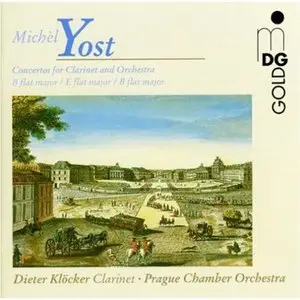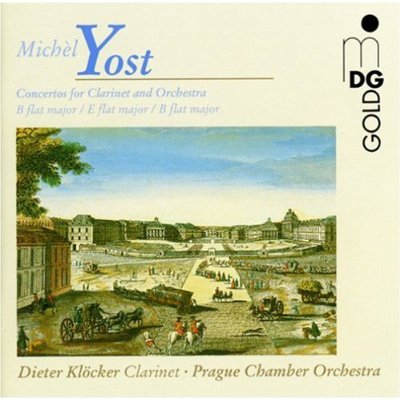April 2024
| Su | Mo | Tu | We | Th | Fr | Sa |
|---|---|---|---|---|---|---|
| 31 | 1 | 2 | 3 | 4 | 5 | 6 |
| 7 | 8 | 9 | 10 | 11 | 12 | 13 |
| 14 | 15 | 16 | 17 | 18 | 19 | 20 |
| 21 | 22 | 23 | 24 | 25 | 26 | 27 |
| 28 | 29 | 30 | 1 | 2 | 3 | 4 |
Yost - Concertos for Clarinet and Orchestra(1997)
Date: 1 Jan 2009 14:09:00
Thanks to my friend Peterson, a funny man, provided the music.
CD: MDG 301 0718-2
Concerto in E flat major / Es-Dur
Concertos No. 7 and 9 in B flat major / B-Dur
Dieter Klöcker, clarinet
Prague Chamber Orchestra
1. Concerto for Clarinet no 11 in B flat major - Allegro
2..Romanze
3.Rondo
4.Concerto for Clarinet no 8 in E flat major - Allegro maestoso
5.Andantino con variazi
6.Rondo
7.Concerto for Clarinet no 9 in B flat major - Allegro maestoso
8.Romanze.Andante
9.Rondo.Allegretto
10.Concerto for Clarinet no 7 in B flat major - Adagio non tanto
11.Rondo
"the music is delightful. It can also amaze us today how such virtuoso music was played on what was most likely a 5 keyed clarinet. Klocker's playing is nimble and has a nice tone." - Amazon
You can listen sample here:http://www./index.php?file=catalogdetail&valbum_code=760623071824
Michel Yost (1754–1786) was a famous clarinetist who died at an early age. Yost, the co-founder of a French clarinet school, was a brilliant and dazzling instrumentalist, a virtuoso in every sense of the 18th Century meaning of this word. He was a composer of concertos, quartets, and duets for his instrument. He was better known by his first name than his last name. Michel was his trademark, and works under this name were published throughout Europe. The Extraordinary beauty of his tone and the accuracy of his playing made him famous outside France as well. No less a figure than Xavier Lefevre numbered among his pupils. Many lexicon entries praise the careful craftsmanship of his compositions, while also indicating that he was incapable of setting forth his musical ideas in the proper form. This was probably why he teamed up with Johann Christoph Vogel. Vogel had a hand in most of Yost’s works but left the design of the figurations up to him. Vogel owed his fame not only to his dramatic compositions but also to instrumental works published under the name of Michel. The fact that such works were team efforts was at first not reflected at all on the title pages. It was only in later years, with the reissuing of works such as those for clarinet and string trio, that this matter was corrected with both Vogel and Yost being credited with their composition.
Michel Yost’s father, who was a native of Switzerland, played the trumpet for the French cavalry. The younger Yost also learned the musical basics from the military masters. Today we may recoil from the fact that a virtuoso made such a beginning, but in the 18th Century this was the usual practice for wind instruments. Here we need only recall the compositional background of the serenades and partitas by Johann Christian Bach, Joseph Haydn, and other composers. The musicians who performed these works either were borrowed from the military bands very often stationed in the royal household or taken from the ranks of town musicians.
Joseph Beer (1744–1811), Yost’s teacher, was the first clarinetist to use an inverted reed. It is held to the lower lip in contrast to the practice of holding the reed to the upper lip. The inverted reed created a sensation throughout Europe. Heinrich Baermann (1784–1847), Carl Maria von Weber’s friend, was also among Beer’s pupils. Mozart also knew the gifted instrumentalist Beer, a native of Bohemia, and dedicated a virtuoso variation work to him. It is a well-known fact that Michel Yost’s performances at the Concerts Spirituel in Paris were major cultural events. His gentle, nimble tone and his virtuoso gifts inspired French composers to rewrite their oboe parts for clarinet and to feature this instrument in their symphonies and concertos.
Owing to their great popularity, Michel Yost’s clarinet concertos circulated throughout Europe. A fruitful synthesis between the musicality of musician Johann Christoph Vogel and the technique of the gifted virtuoso Michel Yost. It is not surprising that their joint efforts continued to serve as models for many clarinetists into the Romantic Era. The charm and grace of their themes have much of Mozart in them, and the fine craftsmanship of their scores is reason alone enough for instrumentalists of the present day to take a new look at this highly talented classical team.
Download



